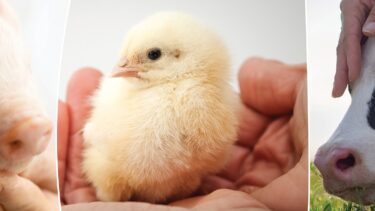Early feeding encourages optimal development of the young animal
Feeding young animals adequately is essential to obtain good zootechnical and economical performances. The birth process, often followed by intensive handling and movements, induces a lot of stress for the young animal regardless if it is a piglet, a calf or a young bird. As Mother Nature does not always provide the young animals with the hard needed nutrients to survive. Hence precise feeding the young animals in an early stage of life will be essential to stimulate the early maturation of their gastro-intestinal tract. The GIT being the first line of defense in disease prevention and responsible for efficient nutrient uptake.
Early life struggles of a day old chicken
Opposite to other species birds have the advantage to have a nutritional storage in their body – the remaining of the yolk sac. On the other hand, unlike other species in professional animal husbandry, the birds, no matter if it is chickens or turkeys, usually have no access to feed directly after hatching. Including the whole process – hatching, grading, sorting, storage, and transport – it can take 24 up to 72 hours until the day old chick is placed at the farms. These circumstances make it obvious, that an adapted early feeding in the poultry house is extremely relevant and important for the later performance.
Besides these external stressors which the young birds has to face after hatch, there is also an abrupt change in nutrition. While the yolk basically consists of fats and proteins in poultry specific molecules, the bird is later confronted with mostly plant-based fats, proteins and, of course, a lot of starch. A well-balanced prestarter can ease this transition.
Promoting piglet feed intake before weaning
During the last decades, genetic selection has led to an enormous increase in litter size. The increased number of liveborn piglets per litter means also more challenges shortly after birth: more light-weight piglets, increased competition for adequate colostrum intake and overall competition for the available sows teats,… All these challenges have led to more vulnerable, low-vital piglets.
A well-balanced and innovative creep feed, supporting the complete litter right from the start, is essential to maximize post-weaning success and profitability. This feed needs to be very palatable to encourage feed intake, needs to stimulate the development of the gastrointestinal tract and provide nutrients to reinforce the health status. A creep feed will not only increase feed intake before weaning, but will also amplify the number of piglets eating before weaning. Increasing this last number will have a positive effect on the overall performance of the piglets after weaning (see Figure 1).

Future milk potential
In dairy farming, future milk production potential is largely determined by health and growth in the first weeks after birth. A challenging period in which most treatments and deaths of the whole two-year rearing period take place. Another challenge is preparing the rumen in such a way that the calf can have a smooth transition from milk to solid feed. Rumen development however can be reduced when too long too much milk/CMR is fed.
In the first half of the milk period the focus is on maximizing growth through a high liquid feed intake. In the second half of the milk period the calf has to be stimulated to increase the solid feed intake through gradual weaning. This leads to a rapid intake of solid feed before weaning which is a guarantee for good performance after weaning.
Young animal nutrition, the first step in your feed & food chain
The objective is to build the link between the maternal/intrinsic nutrition of the young animal and the later feed supply. We want the birds, piglets, and calves to eat as soon as possible resulting in a good development of the gastrointestinal tract. By doing this we will be able to fully exploit their genetic potential and maximize profitability for the farmer.

